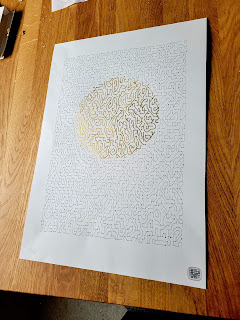I've been seized by an idea, without really understanding what it means...
The last couple of sentences from my last blog entry keep coming back to haunt me:
A kind of gentle light of death? A stillness, not a horror.
I've been thinking about "The Pensive Image" referenced by Jo Love in her guest lecture. I need to read the book to properly understand the idea, but just the phrase is very evocative, and it's lead me to expand on the idea above.
Basically, I'm sensing/feeling/imagining a quality of property of an artwork to somehow evoke a feeling, and that feeling is one of stillness. But not just still in a moment, somehow still in a suspension of time itself. But not a suspension, rather a perfect equilibrium, as though the universe came to a point of perfect balance, and was left just poised there, still, stuck, but at rest.
I think the idea relates to death, but also trauma and shock.
What's interesting is 1) it feels so important but I can't say why and 2) it seems to pull a lot of my previous ideas together in some intangible way. It's also a quality that some of my previous work seems to possess (more or less deliberately), but others don't - clearly a cleaving plane for further reflection and problematisation.
I pondered the idea as I (consequently very slowly!) completed my morning tasks, and wrote down thoughts that come into my head. I described it as
A needle balanced on its point, unable to fall, undisturbed by the air that cannot circulate
Which feels like a good visual representation. I also described it as:
[23:29, 22/11/2024] A stillness, a gentle calm, an abolition of time, not a suspension. Death as a suspension of time, but filled with calm stillness, not horror. A ceasing to be
[08:19, 23/11/2024] A needle balanced on its point, unable to fall, undisturbed by the air that cannot circulate
[08:25, 23/11/2024] The universe at rest, not frozen, perfectly balanced
[08:26, 23/11/2024] Unstable but unbreakable equilibrium
[08:39, 23/11/2024] Perfect equilibrium not stillness
[08:25, 23/11/2024] A null point
The timestamps are because I WhatsApp myself, I'm not some crazied cataloguer of my thoughts ;)
I think 'null point' is a good name for the idea because it has an emotional connection (the position where my daughter's nystagmas least effects her eyes is call the 'null point') but also a science one too (the "zero point" in Quantum Mechanics is where all the particles are at rest).
I wonder if it's like the timelessness I used to get when I meditated?
The strange idea of "The World as it is" seems related somehow - in the moment of the thought, time seems suspended - like I'm snap-shotting the world as it is, somehow.
Some of my work that seems to have this quality already - "Reaching through" with brittle plaster fingers forever reaching, encased in unyielding epoxy, the Waiting Room for Bill of Health, the secret life of spaces series, and the floating face in water (which was never really an artwork so never got a real name, doomed to be forever known by my 'working title' of 'floating face'!)
And yet, many images that SHOULD have it, don't:
Further thoughts:
[23:34, 22/11/2024] Is it a quality of the image, of what the image invokes, of my relationship to the image?
[08:20, 23/11/2024] Past, future, life, death as a quadrant centred on 'now'
[08:29, 23/11/2024] An image that makes the viewer pensive? Or an image that is somehow itself pensive?
[08:41, 23/11/2024] Art is the byproduct of the squeezing of the nut, it's the flashes of colour you get when you squeeze your eyes shut
The last thought is interesting because it brings in "The Squeezing of the Nut", but also suggests a very non-Tomgos approach to art, dangerously close to the mystical! Essentially art as a product of contemplation on an impossible question.
So this idea (if it's even formed enough to deserve the title of 'idea') seems to pull together a lot of strands in my work - death, trauma, science, meditation, balance, the world as it is, the squeezing of the nut, the urge to encase things in resin
So what now?! I'm not sure... I think I want to try to make a piece of abstract work that embodies this quality, and see of that gives me further insight into what the quality is, and why (and if!) it's important. I wonder also if I should ask for a crit on it?
.jpeg)





